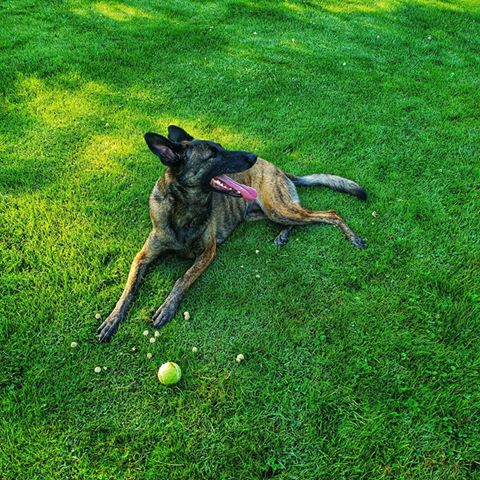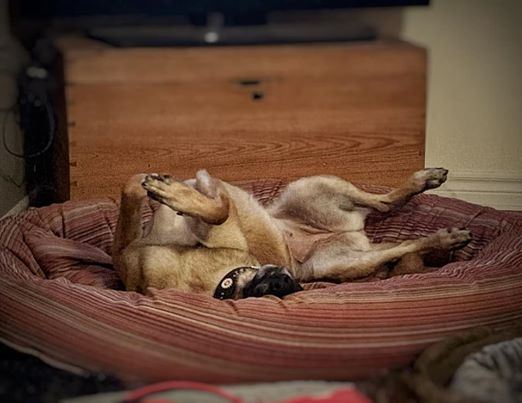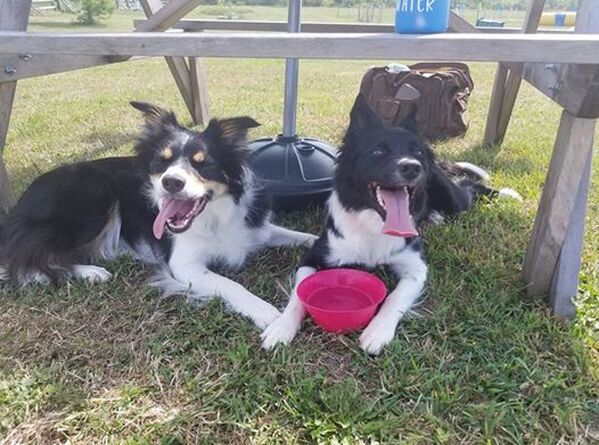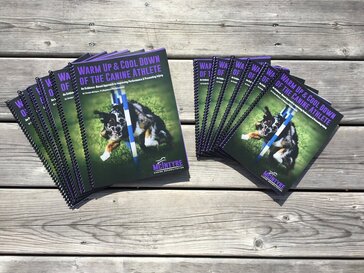|
Has your dog ever told you they quit? Knowing when to take a break is vital in preventing injury - remember, a physically or mentally tired dog is a dog risking injury! The signs of fatigue may not always be clear so it's important to be able to recognize fatigue to combat it during training. Fatigue is a normal consequence of exercise that is continued at a high intensity or for prolonged periods of time. When your dog’s muscles become fatigued, they become unable to continue to perform at the same level of intensity. This decreased ability of the muscle to produce force is a safety mechanism for the body. Fatigue is a warning sign in the body telling us to slow down, but as our dog's can't talk they have to find other ways to show they're feeling tired. This is especially important for us owners of high drive dogs who are not as likely to walk away from work. Knowing these signs of fatigue as well as your dogs typical responses to exercise are the first two steps to preventing fatigue relating injuries. Similar to humans, dogs will become fatigued when completing their conditioning exercises - this is normal! If conditioning exercises are new to your dog, you can anticipate that fatigue will set in a little earlier. As they get more practice and develop a routine and improved endurance for their exercise program, it will take them longer to become fatigued - this is called adaptation!! Signs of Fatigue Think about playing a game of fetch with your dog. Have you ever had you dog return with the ball but instead of delivering it right to you they've laid down a slight distance away? This is a classic sign of avoidance and your dog is telling you they're starting to feel fatigued (Sky, Photo from Kayla Driedger) Appropriate physical training is the most effective way to reduce fatigue and increase the capacity for exercise. Fatigue can also set in if your dog isn’t acclimatized to the weather – make sure to take caution when exercising during very warm and very cold times of the year! Classic signs of fatigue are... • Yawning • Panting • Avoidance such as walking away from the exercise or you (refusing to work) • Difficulty maintaining position/form (e.g. arched or roached back, knees/elbows start to kick out, feet splay, wider stance on equipment) From my experience, when dealing with a high drive dog, the number one marker of fatigue is poor posture/form. Fatigue isn't just physical!Exercise builds on itself increasing your endurance and making you a better athlete. But mental stress, stimulation, and exercise is also exhausting. So during your training session try and keep in mind that new exercises will also mentally fatigue your dog. Common signs of mental fatigue are... • Ground sniffing • Excessive thirst • Loss of self-control • Over-excitement (the zoomies) • Forgetting commands How to combat fatigueThere are several things we can do to help alleviate fatigue. • Give adequate rest after strenuous activity. Muscles need time to recover! • Warm up before exercise and not just before an agility or flyball run. Warming up is also a benefit for dogs going on a long hike or playing at the dog park. Making sure muscles are warmed and primed for activity. Warming up is also easy to do! – usually, only 5-10 minutes is all that is needed. Trotting you dog for about fifty paces is a great short aerobic warm-up! • Cool down your dog after exercise. If you’re on a hike or in a training session this means slowing down the pace of activity so your dog’s heart rate can begin to slow down and return to its normal rate. If you’re in a competition, then after the activity you should walk your dog in a leisurely manner to achieve the same result. And most important of all? Make sure to hydrate your dog! If you're not sure where to start with your warm up and cool down make sure to check out my e-book on the subject. of Incorporate the SAID principle into your conditioning and training programSAID stands for 'specific adaptations to imposed demands'. When the body is placed under some form of stress, it starts to make adaptations that will allow the body to get better at withstanding that specific form of stress in the future - we get good at what we do! It's important to look at all the motion in actions we expect our sport dogs to perform and create exercises that replicate those movements.
When you are developing an exercise program, think about: • Breaking down the movements into their simplest form as much as possible (foundation is key!) • Starting basic and then move to advance/complex • Ensuring you are progressing – increase the level of the stress placed on the body in order to ensure an overload as the body adapts – if we don’t have overload, we don’t have a training effect, which means we receive minimal benefits Remember, muscle fatigue isn’t necessarily a bad thing! In conditioning, we often want to overload muscles as this helps build muscle strength and mental fatigue is often the result of our dog learning! Both positive things but we need to strike a balance between fatigue and over-exertion! Happy Training! Carolyn
2 Comments
Ernie diamond
6/12/2022 09:45:53 am
Hi.my dog seems to be fatigued. She has a PB of 21 AR..lately she is barely achieving 19' she retrieves toys swims at the lake every morning for about 30 minutes . She has dock practice on Wednesdays. Am I over training her? How much rest before competition? She seems excited about jumping abd retrieval but performance has dropped way off..she's a lab mix 60 lbs. I feed her great dogfood..please help
Reply
7/24/2023 04:48:08 am
It made sense when you mentioned that physical training allows dogs to prevent fatigue. My sister told me that her pet is not as active as it used to be. I think it's best to bring her pet to an animal hospital for proper care.
Reply
Leave a Reply. |
AuthorCarolyn McIntyre Archives
March 2024
Categories
All
|




 RSS Feed
RSS Feed